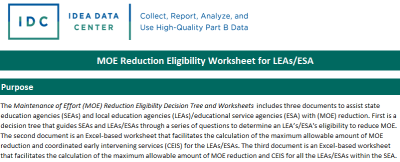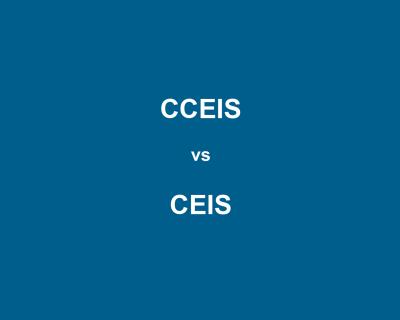
Resource Library
Guides. Briefs. Toolkits. Quick reference information. IDC and its partners created these data quality resources to help states better prepare to address their existing or emerging IDEA data quality needs. Use our search and filtering tools to navigate the library.
Resources 1 - 7 of 9
Format: Guides and Briefs
Measuring Significant Discrepancy: An Indicator B4 Technical Assistance GuideThe TA guide describes the methods a state might use to appropriately determine which of its districts has a significant discrepancy (including a significant discrepancy by race or ethnicity) in the rates of out-of-school suspensions and expulsions totaling greater than 10 days for children with disabilities.
Format: Toolkits
SEA Data Processes ToolkitUsing the SEA Data Processes Toolkit to document data processes for all 616 and 618 data collections will establish a well-managed process for data collection, validation, and submission. In collaboration with IDC State Liaisons, states can use the toolkit to create and maintain a culture of high-quality data and establish and support consistent practices that produce valid and reliable data, while building the capacity of state staff.
Format: Guides and Briefs
The Assessment Data Journey: Are We There Yet?Data for Part B Indicator 3 follow a long and complicated process that begins when a student is registered as a test taker in a state assessment system and ends with public reporting via the SPP/APR. Multiple factors are involved in this process, and regular and ongoing communication and collaboration among the various people involved can make this process easier. This suite of four resources can help states with the work. The interactive infographic provides general information about the process for a typical state.
Format: Guides and Briefs
State Determinations of Local Education Agency (LEA) PerformanceThis resource provides a summary of findings from 28 states’ publicly available LEA determinations processes. States can use this resource to learn more about the data elements, calculation methodologies, and determination category criteria these 28 states used for making LEA determinations. This information can be particularly valuable for those states considering revisions and updates to their own LEA determinations processes.
Format: Applications and Spreadsheets
Maintenance of Effort (MOE) Reduction Eligibility WorksheetsThe Maintenance of Effort (MOE) Reduction Eligibility Worksheets includes two documents to assist SEAs and LEAs/ESAs with MOE reduction. The first is an Excel-based worksheet that facilitates the calculation of the maximum allowable amount of MOE reduction and CEIS for the LEA/ESAs. The second document is an Excel-based worksheet that facilitates the calculation of the maximum allowable amount of MOE reduction and CEIS for all the LEAs/ESAs within the SEA.
Format: Quick Reference
A Comparison of Mandatory Comprehensive Coordinated Early Intervening Services (CCEIS) and Voluntary Coordinated Early Intervening Services (CEIS)In December 2016, OSEP finalized new regulations on significant disproportionality (34 CFR §300.646). These regulations enforce the use of IDEA funds for mandatory CCEIS, which LEAs provide upon identification of significant disproportionality, and distinguish use of funds for CCEIS from the use of IDEA funds for voluntary CEIS. This resource is a handy chart that outlines the differences between CCEIS and voluntary CEIS.
Format: Applications and Spreadsheets
Coordinated Early Intervening Services (CEIS) Fiscal and Student Data TrackerThe Coordinated Early Intervening Services (CEIS) Fiscal and Student Data Tracker is a set of four tools SEAs can use with their districts, schools, and providers to assist them in tracking the finances, services, and student data associated with CEIS. IDC and CIFR produced the CEIS Tracker. The resource also includes an instructions document or user's guide for more information about when and how to use the CEIS Tracker.








